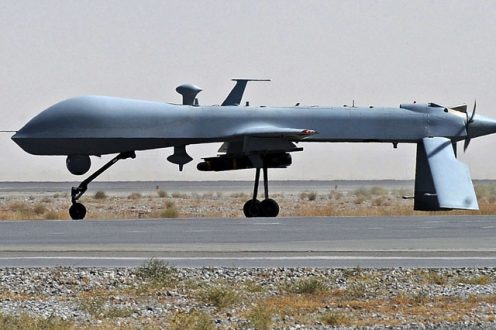Downing of US drone suggests Syria imposing red lines on air war
BEIRUT (Reuters) – After allowing the United States to use its air space to bomb Islamic State fighters for six months, the Syrian army appears to have imposed a “red line” by shooting down a U.S. drone over territory of critical importance to Damascus.
The U.S. military has said it lost contact with one of its drones over northwest Syria but has not given the cause of the incident over Latakia province – part of the western region of Syria where Damascus has been consolidating state control.
Two U.S. officials, speaking to Reuters on condition of anonymity, acknowledged the Predator drone was likely shot down, although the investigation continues.
A Syrian army source said the aircraft was shot down over government-held territory in an area free from Islamic State, the jihadist group that has been facing near daily bombardment by U.S.-led warplanes on the other side of the country.
“Our air defence brought it down with a rocket,” the military source told Reuters. “The plane was American-made, was brought down coming from the sea, and the Syrian air defence was the one that brought it down,” he added.
“The whole region is under state control.”
Four years into Syria’s civil war, Washington still says President Bashar al-Assad has no future in Syria, despite leading an air campaign against jihadist groups that are his most powerful foes on the ground.
Until now, Syria is not known to have fired on U.S. aircraft. The United States says its air strikes are not coordinated with Damascus but Syria says it receives word of them through mutual friends in Iraq.
The drone was shot down about 10 km (6 miles) north of the coastal city of Latakia, according to the military source and the Syrian Observatory for Human Rights, which tracks the war using sources on the ground.
The area is far from the northern and eastern parts of Syria where U.S. and allied warplanes have been launching near daily air strikes against Islamic State positions to roll back the group that has seized wide areas of Syria and Iraq.
Damascus has been consolidating its grip over western Syria, including the Mediterranean coast, even as it has lost control over wide areas of the north and east. The coastal region includes a Russian naval base in Tartous.
The United States has previously described Syrian air defences as “passive,” meaning they have not engaged the U.S.-led coalition’s aircraft as American and other planes carry out strikes against militants.
The U.S. air strikes have not targeted Syrian military forces or military infrastructure.
SENDING A MESSAGE
U.S. officials have not provided word on the drone’s mission, although the fact it was unarmed suggests it was carrying out intelligence collection. Tuesday’s incident took place sometime around 7:40 pm in Syria, when officials said the United States lost contact with the unarmed MQ-1 Predator aircraft.
“If America wanted to send a message – be it for reasons of spying or discovering points of strength or weakness in the Syrian defences – I believe the Syrian response confirmed that violations of Syrian air space are forbidden,” said Salim Harbba, a Damascus-based strategic analyst.
In addition to the regular strikes against Islamic State, U.S. aircraft have also occasionally targeted a separate jihadist group, the al Qaeda-linked Nusra Front, in northwestern Syria, closer to the area of Tuesday’s incident.
The Nusra Front, which shares much of Islamic State’s militant Sunni Islamist ideology but does not recognise its legitimacy, has recently fought with the Syrian military and allied militias in northern Latakia province.
Rami Abdulrahman, who runs the Observatory, said the U.S. drone may have been scouting for al Qaeda-linked militants.
“There have been increased battles in the Latakia area,” he said.
YAHOO NEWS

